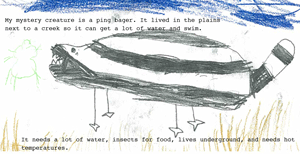IPM Curriculum for Elementary Students Creates InPESTigators

Ask a third grader what a pest is, and chances are the answer will be "My little brother."
But actually teaching them how to identify and decide if something is a pest - and then how to manage it safely - might just be one key to wider adoption of integrated pest management throughout Western schools, according to Deborah Young, professor and extension specialist at Colorado State University.
"In school IPM, we've had a lot of success working with custodians and facilities managers," she said. "And when we ask them how we can help them do IPM at their schools, they say, 'Get the teachers on board.'"
How do you get teachers interested in integrated pest management? Turn IPM into a science curriculum they can use in their classrooms.
So, with a grant from the Western IPM Center, Young and Carrie Foss, the urban IPM director at Washington State University, did just that. The result is “A Classroom InPESTigation: Life Science Curriculum for Grades 3 -5.”
The lessons
The five one-hour lessons teach students:
- What a pest is
- What kind of pest it is
- Why it lives where it does
- How pests can be managed
- How to conduct a classroom “inPESTigation” to see what pests or potential pests might be in their classroom, and ways to prevent or control them
To make sure the curriculum was something teachers could readily use, the IPM specialists hired an education specialist, Ian Renga, a doctoral candidate in education at the University of Colorado, Boulder, to write the actual curriculum and make sure it met Colorado, Washington, and the new federal Next Generation Science Standards.
Then they piloted the curriculum in two third-grade classrooms in Colorado taught by the students’ regular teacher while Renga and Young observed and assisted, then two fourth-grade classrooms in Washington with Renga teaching. That was the fun part.
“If I could just teach third grade all the time, life would be wonderful,” Young said. “The kids were so enthusiastic and came up with great questions.”
Like all good curricula, the IPM lessons are designed to be both complete and adaptable.
“Some pests are different in Washington and Colorado, for instance,” Foss said. “There are opportunities for teachers to adapt it to their settings and even add to it.”
After both pilot sessions the authors tweaked the lessons, and Renga explained that even though the curriculum is now published and available for use, it will evolve as more teachers use it and refine it over time.
“Any curriculum starts as a draft and grows over time,” he said. “It’s a living document.”
The next step is getting teachers to use the IPM curriculum in their classrooms in states throughout the West – and beyond. To do that, Young is working with the Colorado Alliance for Environmental Education to promote the curriculum, and Foss will demonstrate it to 60 primary school teachers at the Entomological Foundation Teacher’s Workshop November 15 in Portland. The workshop is being held in conjunction with the Entomological Society of America’s annual meeting.
“The goal now is to try to create interest among teachers and urban IPM specialists in other states,” Foss said. “It should work in any state.”